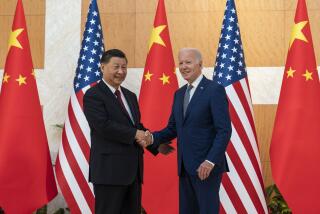A New Prism on Global Competitiveness
- Share via
Zero false modesty, and no apologies to Adam Smith from Michael Porter. The Harvard Business School guru’s unself-consciously titled “The Competitive Advantage of Nations” may glitter with global analyses, but it really burns with ambition. No fewer than 10 countries and a dozen industries are spectroanalyzed through Porter’s prism of competitiveness.
Exhaustive, exhausting and thick enough to choke a python, “Nations” does at least one thing exceedingly well: It reveals just how empty and shallow the current debates about competitiveness really are.
Arguments over capital gains and foreign exchange rates, Japan, venture capital, education, antitrust policy and government subsidies are all secondary or even tertiary issues.
They aren’t meaningful outside the context of a fuller understanding of how a nation--not just an industry--builds competitive advantage in an increasingly global economic marketplace.
What has happened is that the competitiveness debate has been seized by special interests, each shrieking that their particular sliver is the key to unlocking the problem of competitiveness.
What Porter’s book does is identify these special interests for what they really are--fragments of a far more complex and important dynamic.
Just as Smith skewered the mercantilists of his day, Porter--whose texts on strategy have become cult classics for business groupies--wants to shred the conventional wisdoms encrusting global competition, industrial policy and free markets and serve up his own feast of insights for policy makers and business types to chew on.
Where Joseph Schumpeter described “creative destruction,” Porter offers up corporate “clusters” of expertise and complementary skills that shape the domestic dynamics of innovation.
Where David Ricardo spoke of labor differentials as the key to comparative advantage, Porter has “factor conditions”--such as education and training--that address human capital investments.
In fact, Porter presents what he calls the national “diamond” of forces--factor conditions, clusters, the nature of domestic demand (smart customers tend to get innovative products; dull customers get dull products) and the strategies and structures of rival firms--as his model and metaphor to capture the ingredients of national economic advantage.
These forces are the minimum daily requirements for global competitiveness. Without a healthy interplay between these forces, pious proclamations for tax breaks and subsidy are a waste of time.
Porter is nothing if not an articulate apostle of innovation. He inextricably links the quality of national competitive advantage to the quality of technological and organizational innovation.
Porter’s book suffers because, when push comes to shove, he is an academic, not a polemicist--and a book drained of passion is more a set of ideas than an engaging experience. Adam Smith rhapsodized about marketplaces and individual initiative; Porter lugs out and dissects a 10-country database before your eyes.
This is less a book than a compendium. Nevertheless, if you want a powerful new vocabulary to describe what competitiveness means or where innovation really comes from, Porter’s lexicon-cum-atlas is the best one on the (global) market today.
At first glance, there seems to be nothing new in Porter’s analytics. But look deeper and what you find is an intriguing, even rigorous, diagnostic tool to measure how well a domestic industry can hope to do in an increasingly competitive global marketplace.
The examples from Italy’s fluid and ultracompetitive tile industry and Germany’s quality-driven printing press manufacturers are nothing short of compelling.
They reveal a web of formal practice and informal relationships--such as the dozens of high-tech family shops in an Italian village designing tiles--that go far beyond any single industry or government incentive. The diamond becomes a lens that provides a different perspective on the apparently obvious.
Porter dismisses the romantic illusion that entrepreneurial visionaries spring full-blown into the global marketplace, like Athena from the head of Zeus. He convincingly argues that if these national diamonds don’t exist, these entrepreneurs are likelier to end up Don Quixotes than Henry Fords.
More ominously, the erosion of even one point of the diamond--say, the sophistication of the domestic market--can suck the competitiveness out of even the most technically gifted competitor.
Porter’s work is as much borne of frustration as intellectual curiosity. Back in 1984, Porter was a Harvard hotshot named by Ronald Reagan to serve on The President’s Commission on Industrial Competitiveness.
That group, chaired by Hewlett-Packard Chief Executive John A. Young, was launched with great fanfare and quickly became a Washington laughingstock--not because it was a bunch of boobs but because the idea of competitiveness became politicized into ‘industrial policy’ and there was no way the Reagan Administration was going to sully its hands with anything that remotely smacked of interventionism.
No Rose Garden reception here, but a bum’s rush “Thank you so much for your report, gosh, look at the time, got to run” meeting with then-Commerce Secretary Malcolm Baldrige. It was humiliating.
“I was incredulous,” Porter recalls. “I was so annoyed at how ineffective we’d been . . . there was a fundamental lack of understanding of what competitiveness meant . . .” and that led directly to this book.
However, you only hear the frustration and irony when you actually listen to Porter talk instead of read his glacial prose. The interpersonal Porter provides all the passion his book lacks.
Both governments and executive committees misunderstand the new dynamics of globalism, Porter asserts. “There’s a paradox,” he says. “The reality is that even in global markets, domestic rivalry is still important. The notion that we need consolidation by mergers and acquisitions is flawed. We’re taking this notion of risk-reduction much too far. We’re fixated with static efficiency when progressiveness and innovation are far more important.”
In other words, Porter is a fan of policies that promote competition and more competition. He’s also a fan of programs that encourage companies to invest in new technology. “Look at how Japan has encouraged the distribution of robotics technologies by helping set up leasing companies,” he notes.
If you’re looking for algorithms and recipes for global competitiveness, you shouldn’t bother with “Nations”--you’re better off with the reviews.
But managers, entrepreneurs and technocrats in state capitals such as Sacramento, Albany and Boston might discover some useful techniques and models to evaluate their own clusters and subcultures of innovation. Porter has succeeded in writing a significant book.
The odds are that he’s failed to write an important book. Significant books change how people view the world; important books do more--they change how people feel about the world. Adam Smith did that. Michael Porter could have, had he written with the same intensity with which he speaks.
More to Read
Sign up for our Book Club newsletter
Get the latest news, events and more from the Los Angeles Times Book Club, and help us get L.A. reading and talking.
You may occasionally receive promotional content from the Los Angeles Times.










